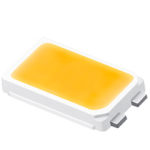LED technology has been with us for quite some time, being part of the daily life of homes and businesses. From the latest developments in industrial high bays to the display lights of household appliances and machinery, LED chips are adapted to the needs of each product, for this reason there are different types of LED chips, do you already know all of them?
LED Types
We can distinguish between four basic types of LEDs:
- LED DIP or Dual In-Line Package
- LED SMD or Surface Mounted Diode
- LED COB or Chip on Board
- MicroLED
Each of them will be described in more detail below.
DIP LED chip
Los DIP DIP (Dual In-Line Package) LEDs are the traditional LED lights and what most people think of when asked to describe an LED. Their design consists of a diode inside a clear hard plastic housing, with two parallel connection pins poking out of it. The color of this casing will determine the light of the LED.

Although DIP chips are still used today, their low luminous efficiency (4 lumens per LED) compared to the most recent LEDs, makes their use more widespread as indicator lights in different electronic products.
SMD LED Chip
SMD stands for “Surface Mounted Diode”, and in this option the diode is encapsulated in a semi-rigid resin that is surface soldered to the circuit. They are much smaller and more efficient than the original DIP chips.

The development of SMD chips was a breakthrough in LED technology, allowing the inclusion of 3 diodes on the same chip. Remember that the way to achieve white light is the union of the 3 primary colors, Red, Green and Blue, hence the importance of this breakthrough. With this combination up to 16 million different colors can be achieved.
The other option to achieve white light is to coat the chip with a phosphor layer that absorbs blue light, hence the distinctive yellow color. The density of this layer determines the color temperature of the SMD chip.
In terms of performance and features:
- SMD chips produce between 60 and 80 lumens per watt, a considerably higher output than previous DIPs, making them the most common chips in LED strips and downlights.
- They emit a unidirectional light, but as they can be distributed over the entire surface of a light fitting, it is possible to achieve a beam angle of 360º.
- Another positive feature is its 80% CRI (Color Rendering Index), providing faithful color reproduction.
- One of the disadvantages of SMDs is the temperature generated at the chip-to-board connection, which makes them unsuitable for operation over a long period of time.
COB LED chip
COB (Chip on Board) LEDs are one of the latest advances in the development of LED lighting, and their design is based on the inclusion of several LED diodes in the same package, reducing manufacturing costs by up to 20% compared to SMD chips.

One of the most widespread applications of COB chips is their use in small devices such as cell phones or cameras, as they generate a high amount of lumens with a very small amount of energy, ideal for the flashes in these devices.
In the performance and features section we would like to highlight:
- They offer a light output that can exceed 120 lumens per watt.
- Despite the concentration of diodes and the light output it provides, the COB design allows efficient heat dissipation, so it is intended for luminaires that need to be kept on for long periods of time during the day.
- Another advantage in terms of durability is its ability to withstand voltage changes in the electric current.
- It is capable of offering a beam angle of up to 160º, emitting multi-directional light.
MicroLED
This technology, as the name suggests, uses a series of microscopic LEDs to define, for example, a pixel. This type of LED chip is becoming increasingly popular in flat panel displays design as it improves on the previous technology in several aspects.
MicroLEDs provide better contrast, lower response time (latency) and higher energy efficiency.
In addition to the solutions focused on lighting, there are other types of designs and applications using LED technology, ranging from electronic products such as televisions, gadgets or cell phones, even to the fashion industry.
At Ledkia we are sure that LED technology will continue to evolve and achieve new milestones, and we will be ready to offer you the best LED lighting solutions as always.


